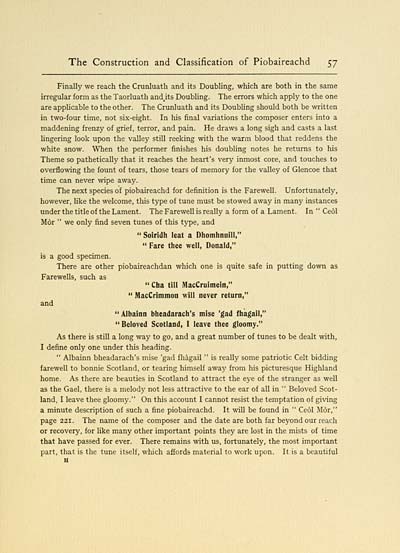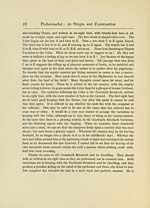Download files
Complete book:
Individual page:
Thumbnail gallery: Grid view | List view

The Construction and Classification of Piobaireachd 57
Finally we reach the Cranluath and its Doubling, which are both in the same
irregular form as the Taorluath and its Doubling. The errors which apply to the one
are appUcable to the other. The Crunluath and its Doubhng should both be written
in two-four time, not six-eight. In his final variations the composer enters into a
maddening frenzy of grief, terror, and pain. He draws a long sigh and casts a last
lingering look upon the valley still reeking with the warm blood that reddens the
white snow. When the performer finishes his doubling notes he returns to his
Theme so pathetically that it reaches the heart's very inmost core, and touches to
overflowing the fount of tears, those tears of memory for the valley of Glencoe that
time can never wipe away.
The next species of piobaireachd for definition is the Farewell. Unfortunately,
however, like the welcome, this type of tune must be stowed away in many instances
under the title of the Lament. The Farewell is really a form of a Lament. In " Ceol
Mor " we only find seven tunes of this type, and
" Soiridh leat a Dhomhnuill,"
" Fare thee well, Donald,"
is a good specimen.
There are other piobaireachdan which one is quite safe in putting down as
Farewells, such as
" Cha till MacCruimein,"
" MacCrimmon will never return,"
and
" Albainn bheadarach's mise 'gad fhagail,"
" Beloved Scotland, I leave thee gloomy."
As there is still a long way to go, and a great number of tunes to be dealt with,
I define only one under this heading.
" Albainn bheadarach's mise 'gad fhagail " is really some patriotic Celt bidding
farewell to bonnie Scotland, or tearing himself away from his picturesque Highland
home. As there are beauties in Scotland to attract the eye of the stranger as well
as the Gael, there is a melody not less attractive to the ear of all in " Beloved Scot-
land, I leave thee gloomy." On this account I cannot resist the temptation of giving
a minute description of such a fine piobaireachd. It vdU be found in " Ceol M6r,"
page 221. The name of the composer and the date are both far beyond our reach
or recovery, for like many other important points they are lost in the mists of time
that have passed for ever. There remains with us, fortunately, the most important
part, that is the tune itself, which afiords material to work upon. It is a beautiful
Finally we reach the Cranluath and its Doubling, which are both in the same
irregular form as the Taorluath and its Doubling. The errors which apply to the one
are appUcable to the other. The Crunluath and its Doubhng should both be written
in two-four time, not six-eight. In his final variations the composer enters into a
maddening frenzy of grief, terror, and pain. He draws a long sigh and casts a last
lingering look upon the valley still reeking with the warm blood that reddens the
white snow. When the performer finishes his doubling notes he returns to his
Theme so pathetically that it reaches the heart's very inmost core, and touches to
overflowing the fount of tears, those tears of memory for the valley of Glencoe that
time can never wipe away.
The next species of piobaireachd for definition is the Farewell. Unfortunately,
however, like the welcome, this type of tune must be stowed away in many instances
under the title of the Lament. The Farewell is really a form of a Lament. In " Ceol
Mor " we only find seven tunes of this type, and
" Soiridh leat a Dhomhnuill,"
" Fare thee well, Donald,"
is a good specimen.
There are other piobaireachdan which one is quite safe in putting down as
Farewells, such as
" Cha till MacCruimein,"
" MacCrimmon will never return,"
and
" Albainn bheadarach's mise 'gad fhagail,"
" Beloved Scotland, I leave thee gloomy."
As there is still a long way to go, and a great number of tunes to be dealt with,
I define only one under this heading.
" Albainn bheadarach's mise 'gad fhagail " is really some patriotic Celt bidding
farewell to bonnie Scotland, or tearing himself away from his picturesque Highland
home. As there are beauties in Scotland to attract the eye of the stranger as well
as the Gael, there is a melody not less attractive to the ear of all in " Beloved Scot-
land, I leave thee gloomy." On this account I cannot resist the temptation of giving
a minute description of such a fine piobaireachd. It vdU be found in " Ceol M6r,"
page 221. The name of the composer and the date are both far beyond our reach
or recovery, for like many other important points they are lost in the mists of time
that have passed for ever. There remains with us, fortunately, the most important
part, that is the tune itself, which afiords material to work upon. It is a beautiful
Set display mode to: Large image | Transcription
Images and transcriptions on this page, including medium image downloads, may be used under the Creative Commons Attribution 4.0 International Licence unless otherwise stated. ![]()
| Early Gaelic Book Collections > Hew Morrison Collection > Piobaireachd > (63) |
|---|
| Permanent URL | https://digital.nls.uk/81164673 |
|---|
| Description | A selection of items from a collection of 320 volumes and 30 pamphlets of literary and religious works in Scottish Gaelic. From the personal library of Hew Morrison, the first City Librarian of Edinburgh. |
|---|
| Description | Selected items from five 'Special and Named Printed Collections'. Includes books in Gaelic and other Celtic languages, works about the Gaels, their languages, literature, culture and history. |
|---|

